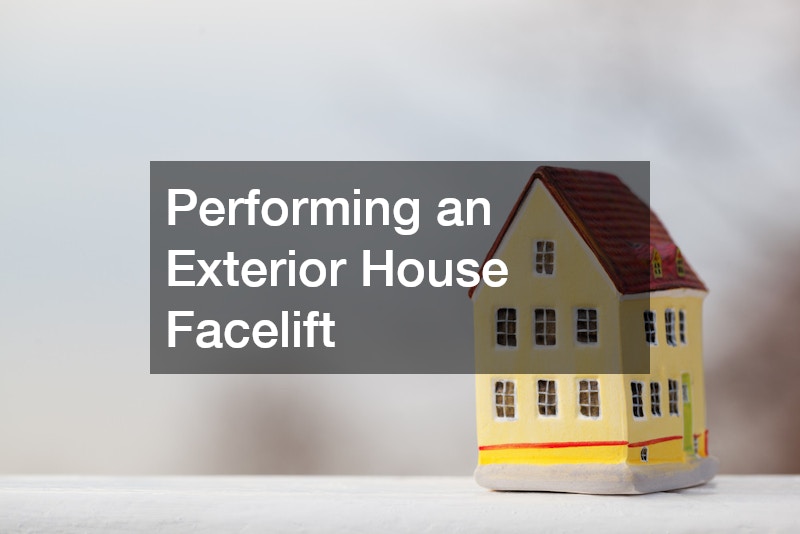
A house facelift is one of the most effective ways to boost your home’s curb appeal and increase its market value. Whether you’re preparing to sell or simply want to rejuvenate your living space, strategic updates to your home’s exterior can make a world of difference. From roofing and siding to landscaping and outdoor lighting, every element contributes to the overall aesthetics and functionality of your property.
Key Elements of an Exterior Facelift

Understanding Curb Appeal
Curb appeal is the first impression your home makes, setting the tone for its overall aesthetic and value. A well-maintained roof, fresh paint, and updated windows and doors contribute to a cohesive and attractive look. These elements not only enhance visual appeal but also increase property value and make your home more inviting to visitors and potential buyers. Small details such as clean pathways, well-kept landscaping, and stylish exterior lighting can further boost your home’s exterior charm.
Importance of Consistency in Design
Choosing a consistent design ensures that every upgrade complements the others, creating a harmonious and well-balanced exterior. A mismatched facade can make even high-quality improvements look out of place. Work with a local roofing company and local landscaping company to maintain a unified aesthetic that aligns with the architectural style of your home. Whether opting for modern minimalism or a classic, traditional look, a strategic approach to colors, textures, and materials will ensure a polished final result.
Material Selection for Durability and Aesthetics
Materials should not only look good but also withstand varying weather conditions, providing both longevity and style. Investing in high-quality materials such as composite roofing, brick, and fiber cement siding can enhance both durability and visual appeal. These materials are designed to resist moisture, temperature fluctuations, and wear over time, reducing the need for frequent repairs. Consider maintenance requirements and long-term benefits when selecting materials to balance cost-effectiveness with lasting quality.
Budgeting for Your Project
Careful financial planning is essential to make the most of your exterior facelift. Prioritizing essential upgrades like gutter replacement, roofing services, and structural improvements can help you maximize your budget effectively. Breaking the project into phases—starting with critical repairs before moving on to cosmetic enhancements—can make the renovation process more manageable. Additionally, obtaining multiple quotes and working with reputable contractors will ensure you get the best value for your investment.
Environmental Considerations
Sustainability is an increasingly important factor in home renovations. Eco-friendly materials, energy-efficient windows, and landscaping companies that use sustainable techniques can contribute to a greener home. Choosing recycled or low-impact materials, incorporating solar-reflective roofing, and planting native vegetation can reduce your environmental footprint while improving energy efficiency. These eco-conscious decisions not only benefit the environment but can also lead to long-term savings on energy and maintenance costs.
Choosing the Right Exterior Paint Color
Analyzing the Neighborhood Context
Your color choice should harmonize with surrounding homes while maintaining uniqueness. Consider the architectural style of your home and those around it—whether it’s a historic neighborhood or a modern subdivision, your selection should complement the existing aesthetic. Additionally, be mindful of any homeowners’ association (HOA) regulations that may dictate acceptable color schemes.
Color Psychology and Mood Setting
Warm tones, such as shades of red, orange, and yellow, can create a welcoming and inviting atmosphere, making your home feel cozy and approachable. On the other hand, cool shades like blues, grays, and greens can provide a sleek, modern touch, often evoking a sense of calm and sophistication. Consider how different hues will affect the mood and curb appeal of your home.
Understanding Paint Types and Finishes
Weather-resistant and UV-protected paints ensure longevity and vibrancy, protecting your home from harsh elements such as rain, snow, and intense sunlight. Additionally, choosing the right finish is crucial—matte or flat finishes can help hide imperfections, while semi-gloss and gloss finishes offer durability and ease of cleaning, making them ideal for trim and accents.
Popular Color Trends
Neutral palettes with bold accents are currently trending, adding character without overwhelming the eye. Soft whites, grays, and earthy tones provide timeless elegance, while deep blues, rich greens, or even black accents on doors and shutters add a striking contrast. Keeping up with trends can enhance your home’s resale value while maintaining its aesthetic appeal.
Testing Paint Samples
Always test colors in different lighting conditions before finalizing. Paint can look drastically different in natural sunlight versus artificial light, and throughout the day as the light changes. Apply samples to different areas of your exterior and observe how they appear at various times to ensure you achieve the desired effect.
Roofing Options Available
Assessing Roof Durability
Choose materials that offer longevity, such as composite shingles with high weather resistance. Metal roofing can last 40–70 years, while slate and clay tiles can endure over a century with proper maintenance. If your area experiences extreme weather conditions, such as heavy snowfall, hurricanes, or high heat, opt for materials specifically designed to withstand these elements. Impact-resistant shingles and wind-rated metal panels can provide extra protection in storm-prone regions.
Energy Efficiency of Different Roofing Types
A roofer can help determine the best material to optimize insulation and reduce energy costs. Light-colored or reflective roofing materials, such as cool metal roofing or solar-reflective shingles, can help deflect heat and reduce cooling costs in warm climates. Conversely, materials like asphalt shingles can provide better insulation in colder regions, keeping heat inside the home. Some roofs can also integrate solar panels to further enhance energy efficiency.
Visual Impact and Style Compatibility
Your roof should enhance the overall aesthetic and complement the architectural style of your home. Traditional asphalt shingles work well with most home designs, while metal roofs offer a modern, sleek appearance. Clay or slate tiles add a classic and elegant touch, especially for Mediterranean or Colonial-style homes. The color of your roof should also coordinate with your exterior paint and trim to create a cohesive and visually appealing look.
Maintenance and Longevity Considerations
Regular maintenance, including gutter replacement, helps prolong roof life. Cleaning debris, inspecting for damaged shingles, and checking for leaks can prevent costly repairs. Metal and slate roofs require minimal upkeep but should still be checked periodically for signs of corrosion or cracking. Proper attic ventilation and insulation also play a crucial role in extending the lifespan of your roof by preventing moisture buildup and reducing heat stress.
Enhancing Your Home’s Exterior with Landscaping

Integrating Hardscaping Elements
Walkways, patios, and stonework add structure and functionality to outdoor spaces. A well-designed hardscape not only enhances visual appeal but also improves accessibility and usability. Materials such as pavers, flagstone, and concrete can define outdoor living areas, creating seamless transitions between different sections of your yard. Retaining walls and decorative edging can also help with erosion control and plant bed organization while adding an elegant touch to your landscape.
Choosing the Right Plants for Your Climate
A local landscaping company can guide you on plants that thrive in your area. Native plants are often the best choice as they are naturally adapted to the local climate and require less water and maintenance. Consider factors such as sun exposure, soil type, and seasonal weather patterns when selecting greenery. Incorporating a mix of perennials and annuals ensures year-round color and texture in your garden.
Designing a Low-Maintenance Garden
Drought-resistant plants and mulch help reduce upkeep. Succulents, ornamental grasses, and native shrubs are excellent choices for those seeking an easy-to-maintain landscape. Using mulch not only conserves moisture and suppresses weeds but also enhances soil health. Additionally, opting for automated irrigation systems or drip irrigation can minimize water waste while keeping your garden lush.
Seasonal Landscaping Tips
Refreshing flower beds and trimming shrubs seasonally keeps your yard vibrant. In spring, planting new flowers and fertilizing lawns can revive your outdoor space. Summer maintenance may include regular watering and pest control, while fall is the perfect time for pruning and adding seasonal plants like chrysanthemums. During winter, protecting delicate plants with mulch or burlap coverings ensures they survive the colder months.
Importance of Pathways and Lighting
Strategic lighting along pathways enhances both safety and beauty. Well-lit walkways prevent accidents and add a warm, inviting ambiance to your home’s exterior. Solar-powered or LED lights are energy-efficient options that can highlight garden features, trees, or water elements. Layering different lighting styles—such as path lights, spotlights, and decorative lanterns—creates depth and dimension in your outdoor space.
Updating Windows and Doors

Choosing Energy-Efficient Windows and Doors
Energy-efficient models improve insulation and reduce energy costs.
Style Considerations for Historical Homes
Preserve the integrity of your home’s original design while integrating modern upgrades.
Security Features to Consider
Smart locks and reinforced glass provide added protection.
Impact of Window Treatments

Well-chosen treatments enhance both privacy and curb appeal.
Installation Tips and Cost Evaluation
Professional installation ensures efficiency and durability.
Selecting the Right Siding Material
Vinyl vs. Wood: Pros and Cons
Vinyl is low-maintenance, while wood offers a timeless aesthetic but requires upkeep.
Benefits of Fiber Cement Siding
Highly durable and available in various styles.
Aesthetic Versatility of Brick and Stone
Brick and stone provide a classic, high-end look with minimal maintenance.
Maintenance and Upkeep Requirements
Power washing and repainting extend the lifespan of siding materials.
Evaluating Cost vs. Longevity
Investing in quality materials pays off in the long run.
Role of Garage Door Design
Popular Garage Door Styles
From carriage-style to modern glass-paneled doors, options abound.
Material Choices and Their Impact
Wood, steel, and aluminum doors each offer different aesthetics and durability levels.
Incorporating Windows for Natural Light
Adding windows creates an inviting feel while improving interior lighting.
Smart Features for Convenience and Security
Remote access and motion sensors add functionality.
Color Coordination with Home Exterior
A cohesive color scheme ensures seamless integration.
Transforming Your Home’s Appearance with Outdoor Lighting
Types of Exterior Lighting Fixtures
Wall sconces, string lights, and floodlights each serve different purposes.
Focal Points: Creating a Lighting Plan
Highlighting architectural features draws attention to key elements.
Balancing Ambience with Security
Motion-activated lights deter intruders while enhancing visibility.
Energy-Efficient Lighting Solutions
LED fixtures offer longevity and lower energy consumption.
Seasonal Lighting Ideas
Festive lights add charm during holidays.
Impact of Fencing on Your Home
Choosing the Right Fence Material
Wood, vinyl, and metal fencing options each have unique benefits.
Fencing Styles and Their Impact on Curb Appeal
A well-designed fence frames your property beautifully.
Privacy vs. Aesthetic: Finding Balance
Choose a height and style that meets your needs.
Regulatory and HOA Considerations
Ensure compliance with local regulations before installation.
Maintenance Tips for Longevity
Regular staining and sealing extend the life of your fence.
Incorporating Sustainable Practices in Your Facelift
Selecting Eco-Friendly Materials
Recycled and sustainable materials are both stylish and responsible. Many modern building materials, such as reclaimed wood, recycled composite decking, and bamboo flooring, offer durability while reducing environmental impact. Using low-VOC (volatile organic compound) paints and sealants improves indoor and outdoor air quality. Additionally, eco-friendly siding options like fiber cement or recycled metal can provide both longevity and aesthetic appeal. Look into composite roofing services for a long lasting, eco friendly option.
Water Conservation Techniques
Rain barrels and drought-resistant landscaping reduce water waste. Installing a rainwater harvesting system allows homeowners to collect and reuse rainwater for irrigation, reducing dependency on municipal water supplies. Xeriscaping, a landscaping approach that uses minimal water, incorporates native plants, mulch, and efficient irrigation methods to maintain a lush yard with less effort. Drip irrigation systems further enhance water conservation by delivering water directly to plant roots, preventing runoff and evaporation.
Energy-Efficient Exterior Upgrades
Cool roofs and energy-efficient doors help lower costs. A cool roof, designed with reflective materials, reduces heat absorption and keeps homes cooler during hot months, decreasing the need for air conditioning. Upgrading to energy-efficient doors and windows with proper insulation and weather-stripping prevents drafts, improving indoor temperature regulation. Solar panels and exterior shading elements, such as awnings or pergolas, can further reduce energy consumption by blocking excessive heat while harnessing renewable energy.
Recycling and Reusing in Renovation
Utilizing a 10 yard dumpster from a junk removal company streamlines debris disposal responsibly. Many demolition materials, such as bricks, concrete, wood, and metal, can be repurposed or recycled instead of ending up in landfills. Habitat for Humanity and similar organizations accept usable building materials, appliances, and fixtures for donation. When planning a renovation, choosing deconstruction over demolition allows for salvaging and repurposing materials, reducing waste and environmental impact.
The Impact of Planting Native Species
Local flora requires less water and maintenance. Native plants are naturally adapted to the regional climate and soil conditions, making them more resilient to pests and extreme weather. They provide essential habitat and food sources for local wildlife, such as birds and pollinators, supporting biodiversity. Additionally, incorporating native species into landscaping minimizes the need for fertilizers and pesticides, promoting a healthier ecosystem while reducing chemical runoff into waterways.
Closing Thoughts
A well-executed house facelift can redefine your home’s appearance, boost property value, and improve functionality. By working with trusted professionals in sealcoating and line striping service, roofing, and landscaping, you can create a visually appealing and sustainable exterior transformation.


